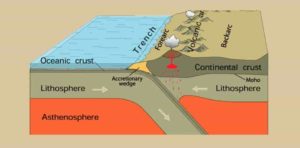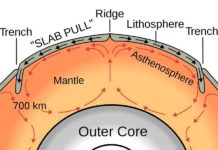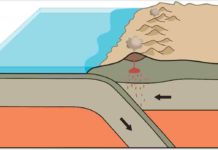
A new understanding of our planet’s deepest earthquakes could help unravel one of the most mysterious geophysical processes on Earth.
Deep earthquakes — those at least 300 kilometers below the surface — don’t typically cause damage, but they are often widely felt. These earthquakes can provide vital clues to understanding plate tectonics and the structure of the Earth’s interior. Due to the extremely high temperature and pressures where deep earthquakes occur, they likely stem from different physical and chemical processes than earthquakes near the surface. But it’s hard to gather information about deep earthquakes, so scientists don’t have a solid explanation for what causes them.
“We can’t directly see what’s happening where deep earthquakes occur,” said Magali Billen, professor of geophysics in the UC Davis Department of Earth and Planetary Sciences.
What’s driving deep earthquakes?
Billen builds numerical simulations of subduction zones, where one plate sinks below another, to better understand the forces controlling plate tectonics. Her recent work helps explain the distribution of deep earthquakes, showing that they most often strike in regions of “high strain” where a sinking tectonic plate bends and folds.
“These models provide compelling evidence that strain rate is an important factor in controlling where deep earthquakes occur,” she said.
The new understanding that deformation is a major factor in deep earthquakes should help scientists resolve which mechanisms trigger deep earthquakes and can provide new constraints on subduction zone structure and dynamics, Billen said.
“Once we understand deep earthquake physics better, we will be able to extract even more information about the dynamics of subduction, the key driver of plate tectonics,” she said.
Her findings were published May 27 in the journal Science Advances.
New way to study deep earthquakes
Deep earthquakes occur in subduction zones — where one of the tectonic plates floating on the surface of the Earth dives under another and is “subducted” into the mantle. Within the sinking slabs of crust, earthquakes cluster at some depths and are sparse in others. For example, many slabs exhibit large gaps in seismic activity below 410 kilometers in depth.
The gaps in seismicity line up with regions of the slab that are deforming more slowly in the numerical models, Billen said.
“Deformation is not the same everywhere in the plate,” Billen said. “That’s really what’s new here.”
Billen’s research was not originally intended to investigate deep earthquakes. Rather, she was trying to understand the slow back-and forth motion of deep ocean trenches, where plates bend downward in subduction zones.
“I decided out of curiosity to plot the deformation in the plate, and when I looked at the plot, the first thing that popped in my mind was ‘wow, this looks like the distribution of deep earthquakes,'” she said. “It was a total surprise.”
Mimicking the deep Earth
Billen’s model incorporates the latest data about phenomena such as the density of minerals, different layers in the sinking plate, and experimental observations of how rocks behave at high temperatures and pressures.
“This is the first model that really brings together the physical equations that describe the sinking of the plates and key physical properties of the rocks,” Billen said.
The results cannot distinguish between possible causes for deep earthquakes. However, they do provide new ways to explore what causes them, Billen said.
“Taking into account the added constraint of strain-rate should help to resolve which mechanisms are active in the subducting lithosphere, with the possibility that multiple mechanisms may be required,” she said.
The project was supported by a fellowship from the Alexander von Humboldt Foundation and an award from the National Science Foundation. The Computational Infrastructure for Geodynamics supports the CitcomS software used for the numerical simulations.
Reference:
Magali I. Billen. Deep slab seismicity limited by rate of deformation in the transition zone. Science Advances, 2020; 6 (22): eaaz7692 DOI: 10.1126/sciadv.aaz7692
Note: The above post is reprinted from materials provided by University of California – Davis. Original written by Becky Oskin.










